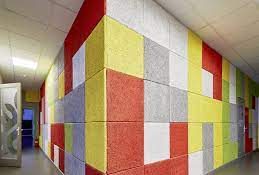In modern architecture, aesthetics and functionality go hand in hand. One design element that has gained popularity in recent years is the wood wool partition wall. These versatile walls not only add a touch of natural charm to interior spaces but also offer remarkable acoustic benefits, making them a preferred choice for both residential and commercial settings. In this blog post, we will delve into the details of wood wool partition walls, exploring their features, installation process, and the advantages they bring to the table.
What are Wood Wool Partition Walls?
Wood wool partition walls, also known as wood fiber panels, are sustainable and eco-friendly building materials that consist of a blend of wood fibers and cement. These panels are manufactured by mechanically shredding wood into fine, slender fibers, which are then mixed with cement and other additives before being pressed into shape.
Features and Benefits
- Natural Aesthetics: One of the primary attractions of wood wool partition walls is their organic appeal. The visible wood fibers add a warm and welcoming character to any space, creating a seamless blend between nature and architecture.
- Acoustic Performance: Wood wool panels possess exceptional sound-absorbing qualities, making them ideal for spaces where noise reduction is essential. They effectively dampen sound reflections, thereby improving the overall acoustic experience.
- Thermal Insulation: Thanks to their inherent composition, wood wool walls provide moderate thermal insulation. This feature contributes to maintaining a comfortable indoor environment and may lead to reduced energy consumption.
- Fire Resistance: Wood wool partition walls are inherently fire-resistant due to the combination of wood fibers and cement. They offer enhanced safety and can act as a barrier in case of a fire outbreak.
- Environmentally Friendly: As eco-consciousness becomes a priority in construction, wood wool partition walls stand out as a sustainable option. The use of renewable materials and minimal chemical additives makes them a greener choice for eco-friendly building projects.
- Versatility: Wood wool panels are available in various sizes, thicknesses, and finishes. This versatility allows architects and designers to explore different design possibilities and cater to specific project requirements.
Installation Process
The installation of wood wool partition wall involves the following steps:
Surface Preparation: Ensure that the surface where the panels will be mounted is clean, dry, and level.
Measurement and Cutting: Accurately measure the dimensions of the area where the wood wool panels will be installed. Cut the panels to the required size using the appropriate tools.
Adhesive Application: Apply a suitable adhesive on the back of the wood wool panel.
Panel Placement: Carefully place the panel on the prepared surface, aligning it correctly.
Securing the Panels: Use screws or nails to firmly secure the wood wool panels in place.
Finishing: After installing all the panels, inspect for any gaps or imperfections. Fill these gaps with an appropriate filler and sand the surface for a smooth finish.
Conclusion
Wood wool partition walls combine the best of aesthetics and functionality, making them an excellent choice for enhancing interior spaces. Their natural charm, acoustic properties, and sustainable nature set them apart as a preferred option for both designers and environmental enthusiasts alike. So, if you’re seeking to add a touch of eco-friendly elegance and optimize the acoustics of your space, consider incorporating wood wool partition walls into your next architectural venture.

